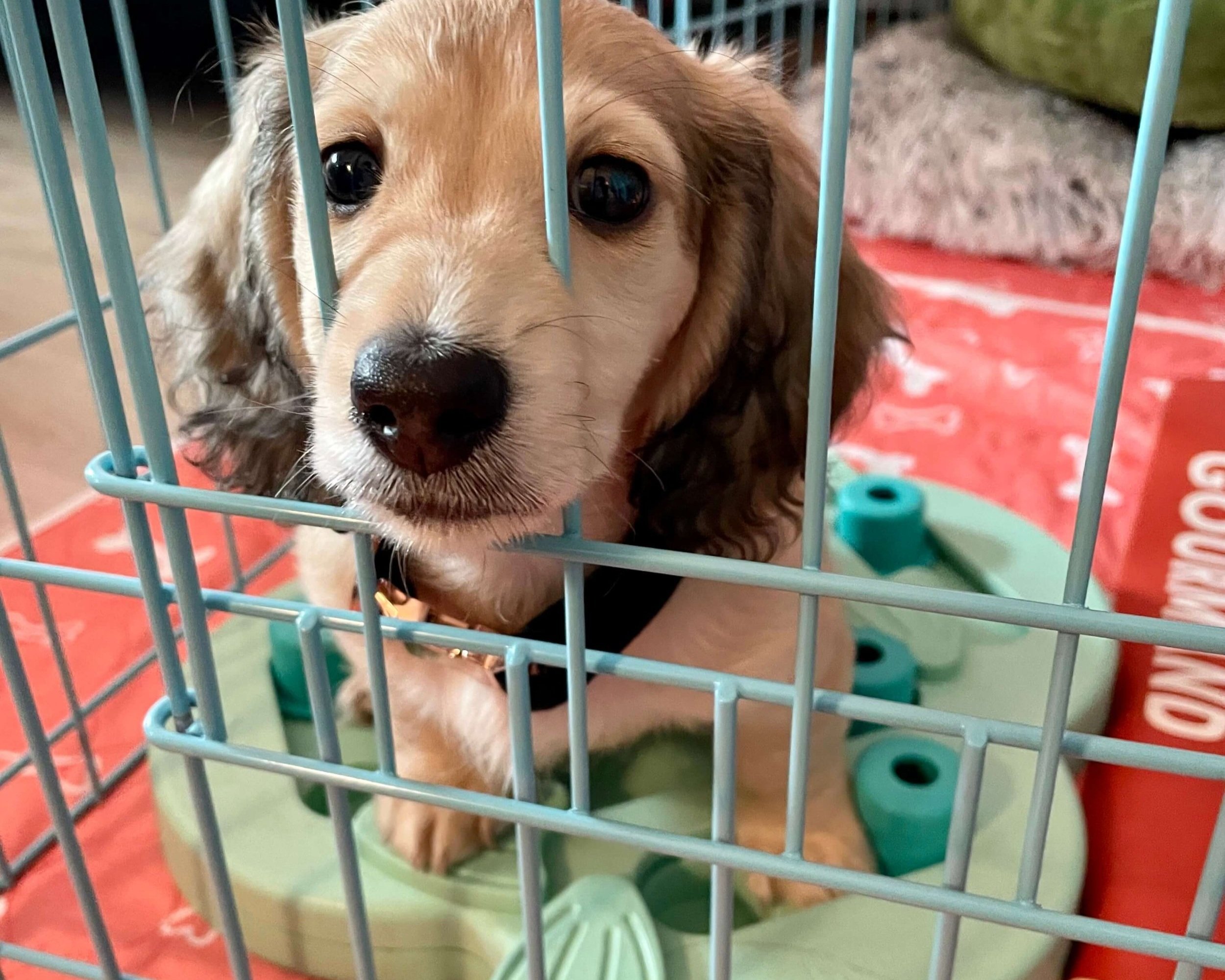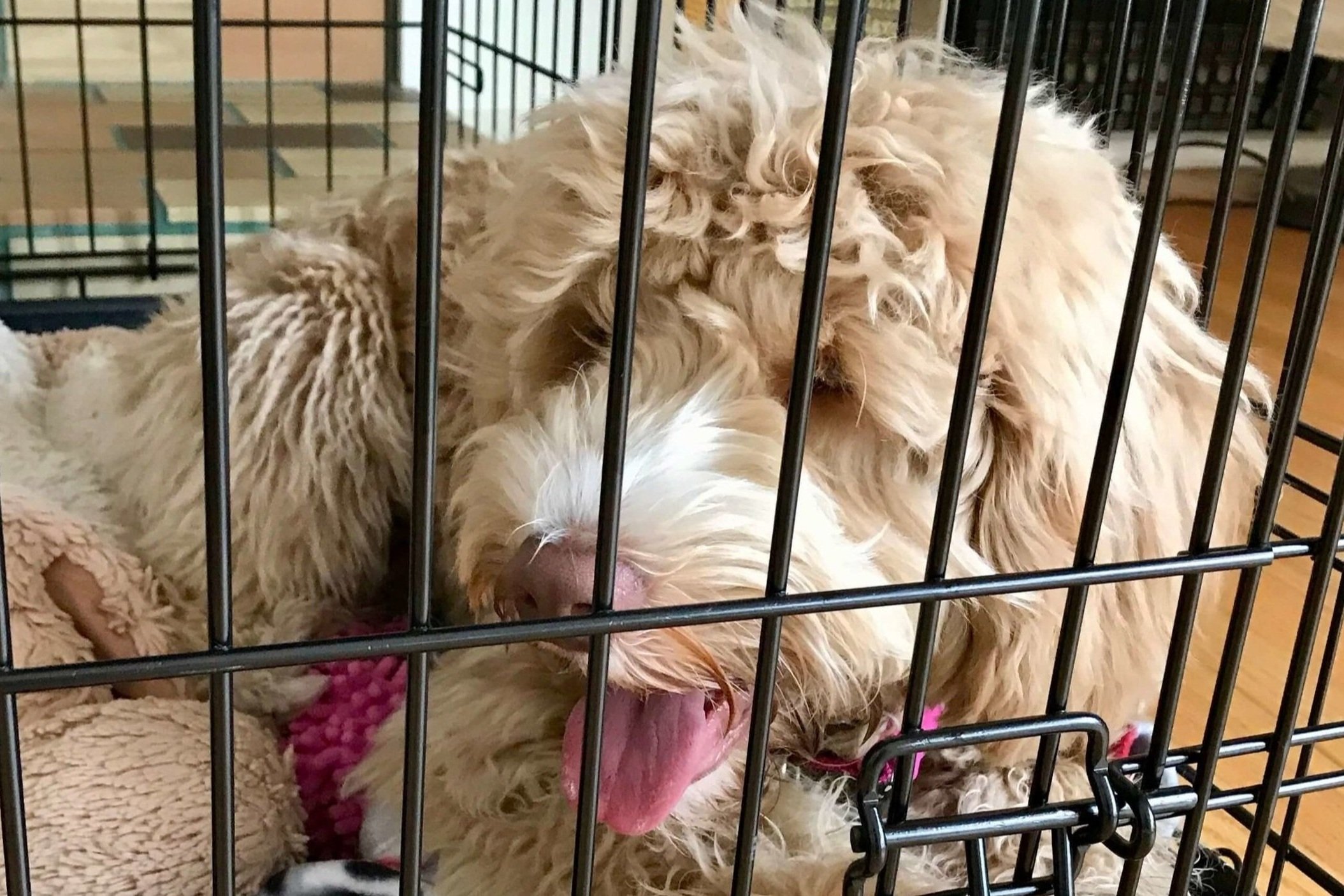Help! My Puppy Hates Its Crate: What Can I Do?
Puppy Training Tips for Crate Success
If you just got a new pup, you may have heard that crate training is the best way to housebreak your puppy and keep them out of trouble when you’re not supervising it.
But, what if your puppy cries, barks, or howls in the crate all night or screams for hours on end when you leave them alone?
If your puppy shows persistent signs of stress and anxiety when confined in a crate or playpen, or when left alone, you may be dealing with puppy separation anxiety.
Similar to a panic attack in humans, a puppy with separation anxiety has difficulty calming down when confined or separated from their pet parent.
In this article, we’ll explore the early signs of puppy separation anxiety, what causes it, and the first steps to help your puppy overcome their fear of being alone or confined.
Why Does My Puppy Cry, Bark, and Howl for Hours in Its Crate?
A puppy may cry in their crate for a number of reasons, including:
Boredom: Puppies may cry to get attention or because they have nothing to do. Puppies are naturally energetic and need mental stimulation.
Needs to go outside: Puppies may cry if they need to urinate or defecate. Since puppies have small bladders, they may need frequent potty breaks, especially during the night.
Negative associations: Puppies may have developed negative feelings about the crate if they were crated for too long, left to cry, or confined with too many other puppies, making the crate feel like a stressful or unsafe place.
Separation anxiety: Puppies may cry because they are lonely and miss their mother and littermates. This is common as they adjust to their new home.
If your puppy’s cries last for 30 minutes or more after being confined in a crate, or if they react similarly when left alone in any space, they are most likely experiencing separation anxiety.
Early Signs of Puppy Separation Anxiety
An example of a puppy with separation anxiety.
Puppies naturally seek comfort and security, especially from their human family, who they see as their “pack.” When confined in a crate, playpen, or left alone, they might feel isolated and anxious. This can lead to excessive whining, crying, barking, or even frantic attempts to escape, which may be early signs of separation anxiety.
The key is understanding that these behaviors aren't acts of defiance but are usually driven by stress and anxiety.
Other key indicators of separation anxiety include:
Body language: A furrowed brow, pinned-back ears, a tucked tail, and wide “whale eyes” (where you see the whites of their eyes) are clear signs of stress.
Loss of bladder or bowel control: An anxious puppy may urinate or defecate in their crate.
Excessive panting, pacing, or drooling: Puppies under stress may pant heavily, pace non-stop, or become soaked in their drool.
Destructive behaviors: Chewing at the crate bars and digging frantically as if attempting to escape can occur if your puppy is in distress.
These symptoms can appear quickly, often within the first five minutes of being confined or left alone. If left unresolved, they may persist for hours until the puppy is freed or reunited with you.
What Causes Puppy Separation Anxiety?
Puppies are naturally pack animals, relying on their pack for safety and survival. When separated from you, they can feel vulnerable and insecure, which activates their instinct to stay close to the pack.
This instinct, deeply ingrained in all dogs, compels them to follow you from room to room, ensuring they remain within their pack’s protection. When left alone or confined in a crate or playpen, they may feel trapped and panic, unable to see or follow you as their instincts demand.
Situations that provoke puppy separation anxiety include:
First time being separated from litter: Puppies separated from their dam and littermates for the first time may struggle with separation anxiety.
Sudden changes: Moving to a new home, changes in routine, or periods of isolation can trigger feelings of insecurity.
Over-attachment: Puppies accustomed to constant attention and physical closeness may find it difficult to cope with being alone.
Understanding this natural urge to stay with the pack and helping your puppy to calm down when their pack instincts are activated is the key to helping your puppy feel more secure when separated from you.
How Puppy Separation Anxiety Can Impact Your Life
Separation anxiety doesn’t just affect your puppy – it impacts your entire household. A puppy that cries all night in their crate can disturb your sleep, cause issues with neighbors, or even create stress in your workday if you're working from home.
To avoid all the fuss, you may decide to stop confining your puppy. But this choice could lead to larger issues down the road when your puppy becomes an adult dog with separation anxiety who can't tolerate being left alone or separated from you when needed.
You might also feel guilty about leaving your puppy alone, which can lead to tough choices. You may find yourself deciding between taking your pup with you everywhere or investing in daycare or a pet sitter, both of which can become quite expensive. This guilt can make it even more challenging to manage your puppy’s separation anxiety, as you want to ensure they feel secure while also maintaining your own routine and responsibilities.
Where to Put Your Puppy’s Crate to Prevent Separation Anxiety
When it comes to crate training your puppy, choosing the right location for their crate is crucial for their comfort and your peace of mind. The best place to put the crate overnight is in your bedroom near the head of the bed. Here’s why this setup works effectively for both you and your puppy:
1. Proximity for Potty Breaks
Placing the crate in your bedroom allows you to hear your puppy if they need a potty break during the night. Puppies have small bladders and may need to go out several times, especially during their early months. Being nearby ensures you can respond promptly to their needs.
2. Providing Comfort and Security
Newly separated from their mother and littermates, puppies are not accustomed to being alone. Puppies are babies; they need to feel safe. Having their crate next to your bed can provide that sense of security. If your puppy wakes up, your presence will help calm them down.
3. Easy Reassurance
If your puppy cries and you’re confident it’s not for a bathroom break (for instance, if they’ve just been out or have access to pee pads), you can easily reach down and place your hand on the door of the crate to comfort them. This reassurance can help soothe their anxiety without necessarily letting them out of the crate, reinforcing that it is a safe space.
Gradual Transition
If your ultimate goal is for your puppy to sleep in a different location, you can gradually move the crate to that area once they are house-trained and more comfortable being alone. This transition can help them adapt to their new sleeping arrangement while still feeling secure.
Daytime Crate Placement
During the day, consider moving the crate to your living area or having a second crate set up there. This way, your puppy can continue to enjoy crate training sessions somewhere they can see you and still feel close to “the pack,” which will help them feel more secure.
How to Train a Crying Puppy to Settle Down in a Crate
While separation anxiety is common in puppies, it is possible to help your puppy learn to feel comfortable being confined or left alone. At Dog Savvy, we’ve developed a method called Doggy Decompression Training to teach puppies to settle down and relax when confined.
Here’s how you can start working with your puppy:
1. Stay Close By Until Your Puppy Settles Down
Many people think letting a puppy “cry it out” will eventually help them calm down. However, leaving an anxious puppy alone often makes things worse. Instead, stay within sight of your puppy so that they know you're nearby. This reassures them that they’re not abandoned.
2. Ignore Crying Without Abandoning Your Puppy
While it's important to stay nearby, avoid rewarding their crying with attention. No talking, no eye contact, and no petting. Simply be present without engaging until they calm down. This teaches your puppy that calmness is the key to getting what they want – your attention and freedom.
3. Give Breaks After Settling
Once your puppy has settled in their crate, reward them by letting them out for a short break. Let them stretch, drink water, or go potty, but keep the interaction low-key to avoid exciting them too much.
4. Use Treats to Create Positive Associations
Every time your puppy returns to the crate, toss a handful of treats inside. This helps create a positive association with the crate and can lower their stress by encouraging them to focus on eating. You can also feed your puppy their meal or a digestible chew in their crate, so they learn it is a safe place to eat and chew on things undisturbed.
5. Repeat and Build
Repeat this process multiple times per session, gradually extending the amount of time your puppy spends in the crate. Over time, this teaches your puppy that confinement isn't a bad thing – it’s a safe, calm place to be.
Troubleshooting Crate Training
If your puppy is struggling to calm down in a crate, here are some additional tips:
Try a playpen: During the day, a playpen gives your puppy more space to move around, which may help reduce anxiety.
Use a soft crate: At nighttime, a soft carry crate can be put on a bed so that a puppy can feel close to you but still be contained.
Soothing strategies: Put a familiar object, like a t-shirt with your scent, in the crate to comfort them. Placing your hand on the side of the crate or playpen to allow them to sniff you and make contact with your fingers can also help to soothe and calm them down.
Common Crate Training Mistakes to Avoid
Using the crate as punishment: The crate should always be a positive space. Never use it to discipline your puppy.
Expecting too much too soon: Some puppies need more time to adjust. Pushing too hard can make anxiety worse.
Not addressing the root cause: If anxiety persists, it’s essential to seek help from a professional to ensure you’re addressing the problem effectively.
In Conclusion: Be Patient and Consistent
By placing your puppy’s crate in your bedroom at night and somewhere they can see you during the day, you’re not only ensuring their comfort and security but also facilitating successful potty training and crate acclimation.
Making sure good things happen in the crate like being fed a meal or getting lots of treats can help a puppy learn to like their crate.
Crate training and overcoming separation anxiety take time, and each puppy is different. Most puppies will start to show improvement within a few weeks of consistent training. However, some may take up to six weeks or more to fully adjust to being alone in a crate.
Need Help Training Your Puppy to Settle Down?
If your puppy is still struggling, don't hesitate to reach out for professional guidance. At Dog Savvy, we specialize in resolving separation anxiety and helping puppies settle into their new homes. Our 6-week virtual puppy separation anxiety training program is designed to help both you and your puppy succeed.
Click the link below to book an intro session with our puppy separation anxiety expert and start seeing improvements today!
About the Author
Alexandra Bassett is the owner, dog trainer, and behavior consultant at Dog Savvy, a private dog and puppy training company specializing in game-based dog training and solving problem dog behaviors like dog separation anxiety, leash reactivity, excessive barking, and aggression.
She is certified as Knowledge Assessed by the Council of Professional Dog Trainers (CPDT-KA) and is available for online dog training sessions via Zoom. To discuss your puppy’s behavior with Alexandra and receive personalized recommendations, book a consultation using the link below.











